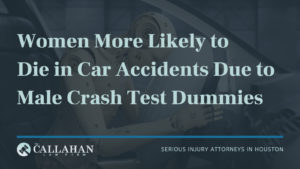Women More Likely to Die in Car Accidents due to Male Crash Test Dummies

Each year, it is estimated that more than 40,000 people die nationwide in automobile accidents. However, though men are statistically more likely to cause and be involved car accidents, women are statistically more likely to die in them. A study done by the National Highway Traffic Safety Administration showed that, compared to men, women are 17% more likely to die in car accidents. In addition, the University of Virginia found that women are 73% more likely to be seriously injured in an automobile accident than men are. Safety advocates believe that this is largely due to the fact that crash test dummies used to recreate accidents are designed to be male, and are based on the size and proportion of the average man.
The Root of the Problem
The average man is about five-foot-nine-inches tall, and weighs about 190 pounds. Comparatively, the average woman is 5-foot-three inches, and weighs 170 pounds.
This means that cars’ safety ratings are determined based on whether or not they can keep men safe—but not necessarily women. Because of this, crash safety testing is somewhat ineffective, because women’s bodies are different than men’s. In addition to differing bone density, muscle and ligament strength, and posture, women have different spinal alignment and mass distribution than men do, as well as differently proportioned abdomens.
Women are also generally shorter than men, meaning that many women sit closer to the steering wheel and more upright than men do, which is not the standard seating position of dummies tested by vehicle manufacturers. Sitting closer to the wheel can alter the angle of the driver’s knees and legs, putting women at greater risk for leg or knee injury when involved a frontal collision.
Research done in Sweden in 2013 found that modern day seat backs are not cushioned enough to keep women safe from whiplash. Their studies found that lighter bodies were more likely to be thrown forward after impacting the back of a firmer car seat, meaning that while the seat would give way for men’s bodies in the face of a rear-end collision, women are more likely to bounce off of the seat back and be flung forward towards their seatbelt, and are thus more likely to experience whiplash. Because vehicles are designed with men in mind, women are much more likely to suffer serious injuries while behind the wheel.
The History of Crash Test Dummies
When crash test dummies were first developed by the United States Air Force in 1949, they were designed based on the male body because women were not included in the armed forces at that time. When crash test dummies eventually became used for vehicle crash safety tests in the 1970s, they continued to be manufactured with the average 50th-percentile male in mind.
Though crash test dummy technology has advanced since its inception in the 1970s, the National Highway Traffic Safety Administration only requires that male dummies be tested for many of its major crash tests. This means that oftentimes, a vehicle given a five-star safety rating was done so with an average man in mind. Excluding half of the population in these tests endangers women.
Searching for Solutions
In the 1980s, researchers began advocating for the adoption of female crash test dummies for safety testing related to car accidents, but both regulators and manufacturers ignored them. To rectify this, some American car companies began using crash test dummies designed to represent women in the 5th percentile (about five feet tall, and 104 pounds) in 2011. However, in addition to excluding a majority of the female population well above the 5th percentile, the “female” dummies tested in these simulated accidents were not actually designed or proportioned like the average woman—instead, they were simply proportioned as male crash test dummies, but scaled down in size. The research done with these “female” crash test dummies was thus ineffective, as the dummies did not accurately represent the female anatomy.
In June of this year, Democratic Congresswoman Eleanor Holmes Norton introduced a bill requiring gender equality in crash test dummies. In a statement, Norton called crash standards “antiquated,” saying that while “women have achieved equality on the road when it comes to driving… when it comes to safety testing to keep them safe on the road, they are nowhere near achieving equality.” In addition, just last month an coalition called Verity Now made up of several former members of Congress and other safety leaders urged Transportation Secretary Pete Buttigieg to make diversity in the use of crash test dummies federal standard. In their letter, they stated that the government-supported gender bias causes “thousands of women to be needlessly killed and injured every year.”
Automobiles have come a long way since the car was first patented over a century ago, as has motor vehicle safety. Unfortunately, despite the rapid innovation of major safety features, much of the population remains excluded, and thus, unsafe. Until female crash dummy testing is made a worldwide standard, automobile makers will continue to consider the safety of half of our population as optional.
—
If you or a loved one has been injured in a car accident, contact The Callahan Law Firm today. Our legal team has been successfully representing injured people and their families for over 25 years, and we can help you too. Give us a call at 713-224-9000, or fill out our contact form here.

Michael S Callahan is an attorney and founder of The Callahan Law Firm. He focuses his practice on representing individuals and families in personal injury cases involving motor vehicle and truck accidents, workplace accidents and defective products. With over 25 years of experience, he is dedicated to fighting on behalf of people whose lives have been forever altered by the negligence and carelessness of corporations and individuals. Originally trained as a mechanical engineer, Michael has been practicing law and fighting for justice for those who need it most since 1994. He is board-certified in Personal Injury Trial Law by the Texas Board of Legal Specialization and a member of various esteemed legal associations. Outside of work, Michael enjoys spending quality time with his family, outdoor activities, and continually striving to improve as a trial lawyer and human being.











